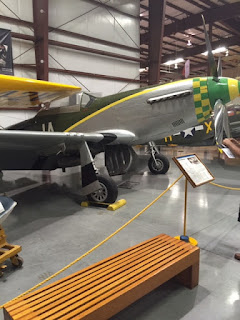During the first leg of my first trip to the Yanks Air Museum, I took a tour of all American aircraft designed and built in the 1900-1920 period and the Golden Age of Aviation. It's common knowledge that most US aircraft manufacturing during the first two decades of powered flight took place on the east coast but also in Ohio, but the Loughead brothers Alan and Malcolm set up the first aviation company along the West Coas tin San Francisco, in 1912, paving the way for men like William Boeing and Donald Douglas to establish an aircraft manufacturing base on the Pacific Coast. Off all the planes from the hangar covering the early aviation period and Golden Age of Aviation, there was only one plane from this era built in southern California, the Ryan B-1 Brougham.
 |
| Ryan B-1 Brougham NC1159 (top); Ryan B-1 Brougham NC6956 at the Yanks Air Museum (bottom) |
The B-1 Brougham was a high-wing monoplane airliner similar in most respects to the Ryan Aeronautical Company's M-1 mailplane, but it differed from the M-1 in that it had a fully enclosed cabin for both the pilot and the passengers. Early Broughams, including the B-1 variant I saw on display at the Yanks Air Museum, used a Wright J-5 Whirlwind, but the later B-5 and B-7 used a Wright J-6 and Pratt & Whitney Wasp engine respectively. A total of 212 Broughams were built, and they served small US airlines as well as foreign countries like China, Guatemala, Mexico, and El Salvador. One Brougham was used by John Moncrieff and George Hood in their ill-fated January 1928 attempt to cross the Tasman Straits between southern Australia and Tasmania.
  |
| Side front view (left) and oblique rear view (right) of North American B-25J Mitchell serial number 44-86791 |
The Legends Hangar containing WW2 aircraft was, in my view, quite ubiquitous for containing military planes built in Southern California during the war. One interesting aspect of the WW2 planes that I saw on display in this hangar is that three of them that were made in Southern California were built by Inglewood-based North American Aviation: the P-51 Mustang fighter and B-25 Mitchell medium bomber. The B-25 Mitchell was made famous by the April 1942 Doolittle Raid on Tokyo, and it bore the name of General William "Billy" Mitchell (1879-1936), an early advocate of American airpower. The B-25 Mitchell medium bomber I saw on display was built three years after the Doolittle Raid and given the serial number 44-86791. It was purchased by Ace Smelting of Phoenix, Arizona, in May 1959, and later was used by civil operators in Fairbanks, Alaska.
  |
| Front side view (left) and front view (right) of P-51D Mustang Miss Judy (serial number 44-74910) |
  |
| North American SNJ-5 Texan BuAer No.43771 at Legends Hangar |
The third airplane built by North American Aviation that caught my eye at the Legends Hangar was the North American AT-6/SNJ/T-6 Texan. Known to the British as the Harvard (in accordance with the Royal Air Force tendency to name trainers after academic institutions [Note: American trainers were named for American academic institutions by the RAF]), the Texan was the most mass-produced and widely used Allied trainer aircraft of World War 2, with a total of 15,495 aircraft built for the US Army Air Force, US Navy, and the armed forces of the British Commonwealth. Given that the Army Air Force and Navy had different designation systems for their aircraft, the Texan was designated BC-1, BC-2, AT-6, and AT-16 by the USAAF, and the SNJ and TJ by the Navy. The Texan trainer I saw at the Legends Hangar was of the SNJ-5 version, of which 1,357 were built.
 |
| A P-38L Lightning (serial number 44-27183), later converted to F-5G configuration, photographed by me in the Legends Hangar of the Yanks Air Museum on July 10, 2016. |
The Lockheed P-38 Lightning on display in the Legends Hangar has a superfluous operational history. Bearing the serial number 44-27183 and christened 23 Skidoo, it was built as a P-38L, the most mass-produced P-38 variant, of which 3,923 aircraft were built (113 made by Vultee). Photo-reconnaissance versions of the P-38 Lightning (designated F-4 and F-5 by the US Army Air Force) were used for reconnaissance flights in the European and Pacific theaters of World War II, and the P-38L with serial number 44-27183 was one of an unknown number of P-38Ls converted to the F-5G variant, which differed from the F-5F (also a reconnaissance conversion of the P-38L) in having revised nose contours to provide extra space for photographic equipment and a wider selection of cameras. After World War II, it was used for aerial survey of the North Pole by Kargl Aerial Surveys, Mark Hurd Aerial Surveys, Pacific Aerial Surveys, and the Aero Exploration Company, operating in this capacity until the 1970s. In the late 1980s, this aircraft was donated to the Yanks Air Museum, where it remains on static display to this day.





No comments:
Post a Comment